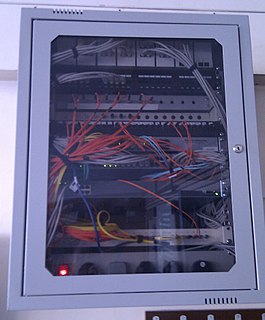Related Research Articles

Electrical engineering is an engineering discipline concerned with the study, design, and application of equipment, devices, and systems which use electricity, electronics, and electromagnetism. It emerged as an identifiable occupation in the latter half of the 19th century after commercialization of the electric telegraph, the telephone, and electrical power generation, distribution, and use.

In telecommunications and computer networking, multiplexing is a method by which multiple analog or digital signals are combined into one signal over a shared medium. The aim is to share a scarce resource. For example, in telecommunications, several telephone calls may be carried using one wire. Multiplexing originated in telegraphy in the 1870s, and is now widely applied in communications. In telephony, George Owen Squier is credited with the development of telephone carrier multiplexing in 1910.

In telecommunications, a network interface device is a device that serves as the demarcation point between the carrier's local loop and the customer's premises wiring. Outdoor telephone NIDs also provide the subscriber with access to the station wiring and serve as a convenient test point for verification of loop integrity and of the subscriber's inside wiring.
TAT-8 was the 8th transatlantic communications cable and first transatlantic fiber-optic cable, carrying 280 Mbit/s between the United States, United Kingdom and France. It was constructed in 1988 by a consortium of companies led by AT&T Corporation, France Télécom, and British Telecom. AT&T Bell Laboratories developed the technologies used in the cable. The system was made possible by optical amplifiers acting as repeaters with advantages over the electrical repeaters of former cables. They were less costly and could be at greater spacing with less need for associated hardware and software. It was able to serve the three countries with a single transatlantic crossing with the use of an innovative branching unit located underwater on the continental shelf off the coast of Great Britain. The cable lands in Tuckerton, New Jersey, USA, Widemouth Bay, England, UK, and Penmarch, France.
In the seven-layer OSI model of computer networking, the physical layer or layer 1 is the first and lowest layer; The layer most closely associated with the physical connection between devices. This layer may be implemented by a PHY chip.

Photonics is the physical science and application of light (photon) generation, detection, and manipulation through emission, transmission, modulation, signal processing, switching, amplification, and sensing. Though covering all light's technical applications over the whole spectrum, most photonic applications are in the range of visible and near-infrared light. The term photonics developed as an outgrowth of the first practical semiconductor light emitters invented in the early 1960s and optical fibers developed in the 1970s.
Hybrid fiber-coaxial (HFC) is a telecommunications industry term for a broadband network that combines optical fiber and coaxial cable. It has been commonly employed globally by cable television operators since the early 1990s.
A passive optical network (PON) is a fiber-optic telecommunications technology for delivering broadband network access to end-customers. Its architecture implements a point-to-multipoint topology in which a single optical fiber serves multiple endpoints by using unpowered (passive) fiber optic splitters to divide the fiber bandwidth among the endpoints. Passive optical networks are often referred to as the last mile between an Internet service provider (ISP) and its customers.

The history of telecommunication began with the use of smoke signals and drums in Africa, Asia, and the Americas. In the 1790s, the first fixed semaphore systems emerged in Europe. However, it was not until the 1830s that electrical telecommunication systems started to appear. This article details the history of telecommunication and the individuals who helped make telecommunication systems what they are today. The history of telecommunication is an important part of the larger history of communication.

Fiber to the x or fiber in the loop is a generic term for any broadband network architecture using optical fiber to provide all or part of the local loop used for last mile telecommunications. As fiber optic cables are able to carry much more data than copper cables, especially over long distances, copper telephone networks built in the 20th century are being replaced by fiber.
In telecommunications, an optical buffer is a device that is capable of temporarily storing light. Just as in the case of a regular buffer, it is a storage medium that enables compensation for a difference in time of occurrence of events. More specifically, an optical buffer serves to store data that was transmitted optically, without converting it to the electrical domain.

A network on a chip or network-on-chip is a network-based communications subsystem on an integrated circuit ("microchip"), most typically between modules in a system on a chip (SoC). The modules on the IC are typically semiconductor IP cores schematizing various functions of the computer system, and are designed to be modular in the sense of network science. The network on chip is a router-based packet switching network between SoC modules.

Fiber-optic communication is a method of transmitting information from one place to another by sending pulses of infrared light through an optical fiber. The light is a form of carrier wave that is modulated to carry information. Fiber is preferred over electrical cabling when high bandwidth, long distance, or immunity to electromagnetic interference is required. This type of communication can transmit voice, video, and telemetry through local area networks or across long distances.

Telecommunications Engineering is an engineering discipline centered on electrical and computer engineering which seeks to support and enhance telecommunication systems. The work ranges from basic circuit design to strategic mass developments. A telecommunication engineer is responsible for designing and overseeing the installation of telecommunications equipment and facilities, such as complex electronic switching systems, and other plain old telephone service facilities, optical fiber cabling, IP networks, and microwave transmission systems. Telecommunications engineering also overlaps with broadcast engineering.
Sumitomo Electric Industries, Ltd. is a manufacturer of electric wire and optical fiber cables. Its headquarters are in Chūō-ku, Osaka, Japan. The company's shares are listed in the first section of the Tokyo, Nagoya Stock Exchanges, and the Fukuoka Stock Exchange. In the period ending March 2021, the company reported consolidated sales of US$26,5 billion.

Aleksandra Smiljanić was the Minister of Telecommunications and Information Technologies in the Government of Serbia from 2007 to 2008.
Telecommunications equipment is a hardware which is used for the purposes of telecommunications. Since the 1990s the boundary between telecoms equipment and IT hardware has become blurred as a result of the growth of the internet and its increasing role in the transfer of telecoms data.

An optical mesh network is a type of optical telecommunications network employing wired fiber-optic communication or wireless free-space optical communication in a mesh network architecture.

Telecommunication is the transmission of information by various types of technologies over wire, radio, optical, or other electromagnetic systems. It has its origin in the desire of humans for communication over a distance greater than that feasible with the human voice, but with a similar scale of expediency; thus, slow systems are excluded from the field.

Keren Bergman is an American electrical engineer who is the Charles Batchelor Professor at Columbia University. She also serves as the director of the Lightwave Research Laboratory, a silicon photonics research group at Columbia University. Her research focuses on nano-photonics and particularly optical interconnects for low power, high bandwidth computing applications.